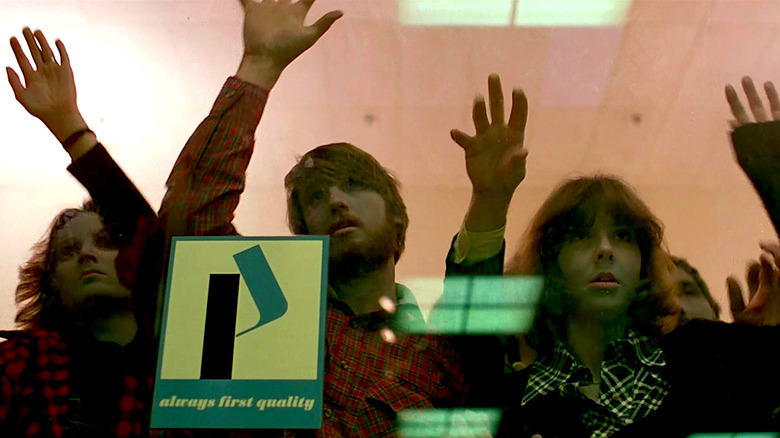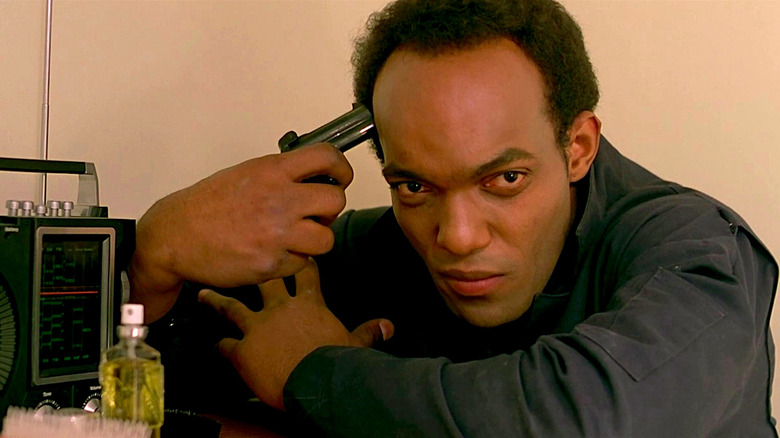Why George Romero Decided To Use An Alternate Ending For Dawn Of The Dead
It's impossible to forget the ending to George A. Romero's classic, "Night of the Living Dead." After a long night of battling zombies while trapped inside an old house, Ben (Duane Jones), the sole survivor of the group of rag-tag individuals thrown together by chance, emerges from the cellar hoping to be rescued by the police that have finally arrived on the scene. For a brief moment there is hope, but then this hope is eviscerated as the police mistake Ben, who is a Black man, for a zombie, and shoot him dead on the spot. No one makes it out alive, and Ben's ironic death serves as a profound message to viewers about the tensions and terrors that exist between law enforcement and Black lives. Released in 1968, "Night of the Living Dead" was bold in its willingness to blend social commentary into a horror movie, but the film's ending still remains pertinent today, making it one of the greatest horror films of all time.
This devotion to social commentary is a common theme throughout all of Romero's films, and the rest of his "Dead" films all have their own, specific cultural bone to pick. The sequel to "Night of the Living Dead" turns its critical lens on conspicuous consumption in "Dawn of the Dead." Taking place almost entirely in a mall, "Dawn" is a spunkier film than its predecessor, developing a playful tone despite all the death going on around the main characters. It's a survivalist movie with a heart of gold, and its ending is completely opposite "Night of the Living Dead" in every way.
In the film's final moments, Peter and Fran, having lost their companions to zombification, bravely fight their way to the roof where a helicopter is waiting. Their escape is not without its complications — at one point, a disconsolate Peter contemplates suicide in the face of an oncoming zombie hoard — but the pair ultimately choose to fight to the end, making it to the helicopter just in time. Whether or not the duo survive for much longer after their escape is unknown. But at least for now, within the confines of the film, Romero gives us a little hope that they just might. This decision makes "Dawn of the Dead" one of the best installments in the series, but its upper of an ending was not originally planned.
Maybe don't kill your darlings, after all?
It turns out that Romero originally intended to repeat the hopelessness in the ending of "Night of the Living Dead" by killing off all of the film's main characters. No one was supposed to make it out of that mall alive, least of all Peter and Fran. After Peter shoots a reanimated Stephen, he finds himself weighing his odds of survival. Does he take a chance at making a dash for the roof where he might be able to board the helicopter and get away? Or does he preserve his dignity by ending his life on his own terms, ensuring the toxic zombie virus never corrupts his mind? He ultimately chooses to keep fighting, but originally, he was supposed to die by suicide. Fran was also supposed to die by suicide on the roof after coming to the realization that she wouldn't survive the onslaught of zombies. Not wanting to reanimate, she was set to thrust her head into the rotating helicopter blades ensuring her demise.
If Romero had chosen to go ahead with the original ending, the at times playful tone of "Dawn" would have shifted into a major "Oh s***!" moment where the stark reality of the virus's devastation on the human brain and body would be made devastatingly clear. Romero's message, especially after the ending of "Night of the Living Dead," would seem to suggest that there is no escape from the zombies, which in turn would suggest there is no escape from the evil that plagues societies. Thankfully for us (and for Fran and Peter), Romero changed his mind and allowed the two to live a little longer.
ScreenRant reports that, "Romero took notice of how 'Dawn of the Dead's' tone was often much more lighthearted and upbeat than anything in the relentlessly dour 'Night of the Living Dead,' and came to the conclusion that a less bleak ending would be appropriate." It also helped that Romero, himself, had grown attached to his characters and simply did not want to see them killed, so in direct defiance of the popular writer's adage, he simply refused to kill his darlings, and the movie is ultimately better for it.

